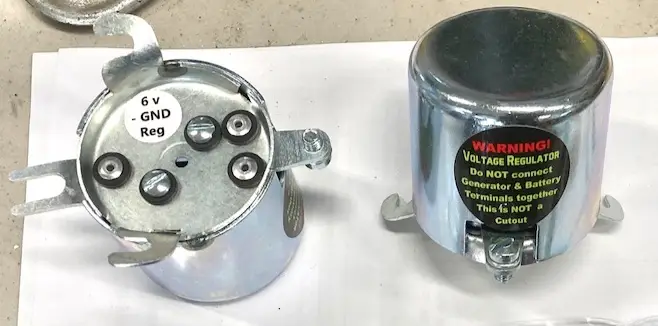Voltage Regulator Operation & Tips – Part 2
In the previous post I described how the FPVR operates. In this article I’ll describe how my VR (MTSVR) operates and why we chose this design.
As mentioned previously, the FPVR is a proportional charger. If the battery is fully charged, there is no or very little movement on the ammeter. This can be a little disconcerting for Model T folks who are used to seeing their meter move. With this in mind, we had an idea. What if we designed our regulator to be either ON or OFF. if the battery needs to be charged, it’s ON. When it’s fully charged, it is OFF. Either design will keep any battery optimally charged for use and these designs are both widely used in commercially available battery chargers. Either method does a great job of keep a battery charged.

The benefit with the MTSVR is when you first start your car, you will immediately see the VR charging the battery at whatever charge current you have your 3rd brush set for, assuming your motor is revved to driving speed (not idling). Once the battery voltage reaches approximately 7.2v, the regulator turns off and the ammeter will show a discharge until the battery voltage drops to approximately 6.1v and will then turn back on. The cycle then repeats and you can watch it happen. When it’s off, turn your lights on or press your brake light and you’ll see the regulator kick in and turn back on.
There is NO DOUBT about whether or not it is working. It’s painfully obvious – it’s either ON or its OFF. It is normal to see this cycle repeat at different intervals depending on what is turned on in your car. If your incandescent headlights are on, it might stay on all the time. When I use my LED headlights while driving they only draw a measly 1A, so it’s off most of the time. Only when the battery voltage drops to ~6.1v does the MTSVR turn on.A couple scenarios are instructive. Let’s say you have your 3rd brush set for 5A as I recommend. You might see this on/off cycle occur every 2 -5 minutes after driving for a while and the battery gets “topped up” and fully charged. It could go on for only a few seconds, then off for a couple of minutes or longer. Perfectly normal.Let’s say you set your 3rd brush for 10A which I do NOT recommend, but it will work. You’ll see it ON for a 1-2 seconds, then off for a little longer, and repeat at a much more rapid rate. This is because if you’re pumping 10A into your battery and the draw is low (say, just your coils) the battery tops up quickly, thus causing the regulator to turn off quickly. Setting a high rate of charge will also cause your headlights to flicker when the regulator kicks on & off. Its much better to set your 3rd brush to a nominal 5A (or 2-3A with LED headlights) or so, not tax your generator and let the MTSVR do it’s job.

I had the LED flicker issue and my charge rate was initially set for 9A. I reduced it to 3A and the flicker went away and the meter then showed a charge for 10 seconds or so and then off for a minute or more. My battery stays completely charged. This is great because I’m no longer taxing my ancient generator.
You recommend a charge rate of 5 amps. I run 12 volts on my T’s, do you recommend the same charge rate?
These T gens are rated for 100watts (max) output, and P=VI, so 6v*5A=30watts at 6v. 12v*5= 60watts, so that’s within the allowable range although I’d tend to run it a bit lower just to prolong the life of your generatior. You can experiment and see if 3-4A keeps the battery charged (it should). If not then try 5 A.